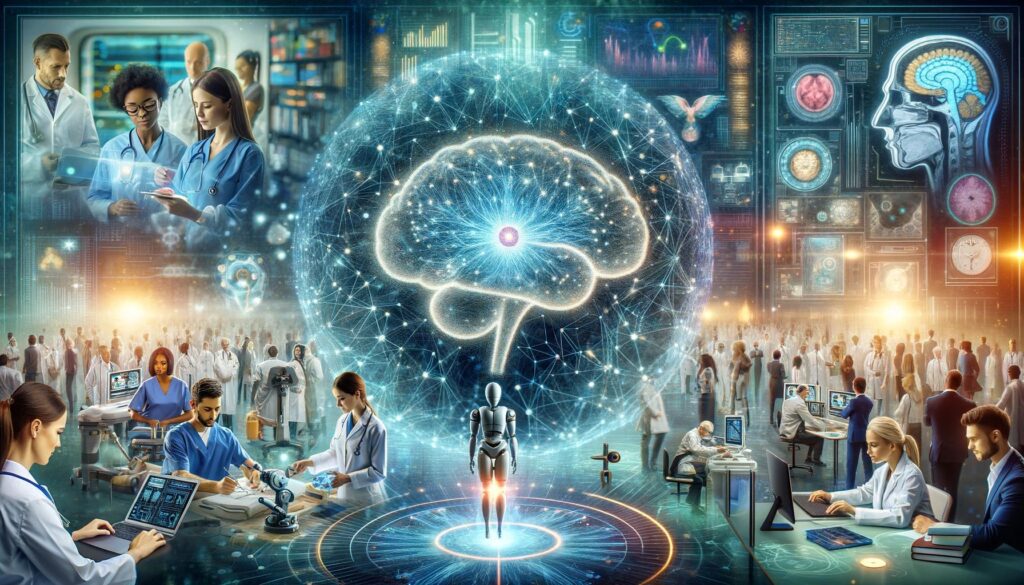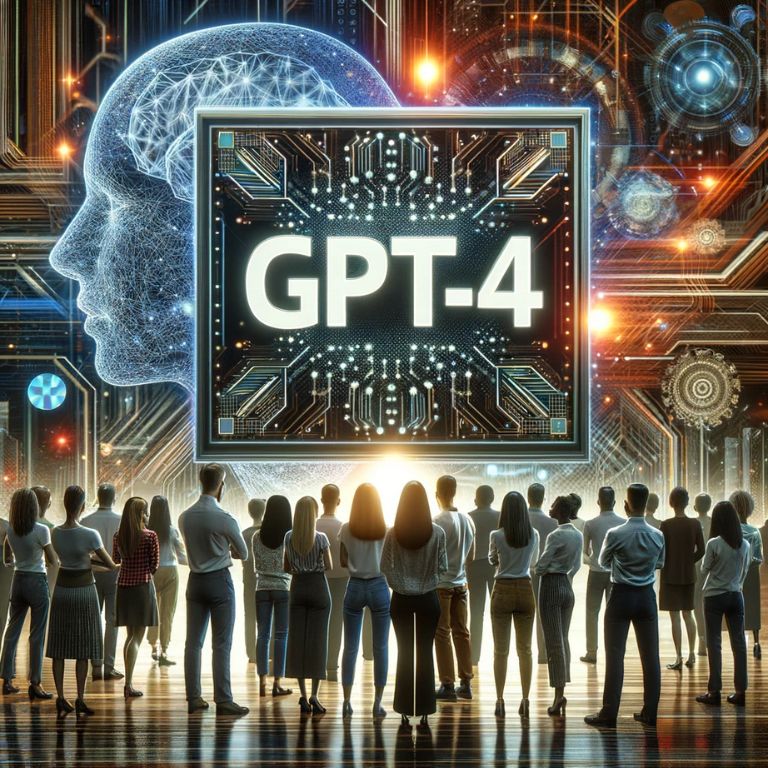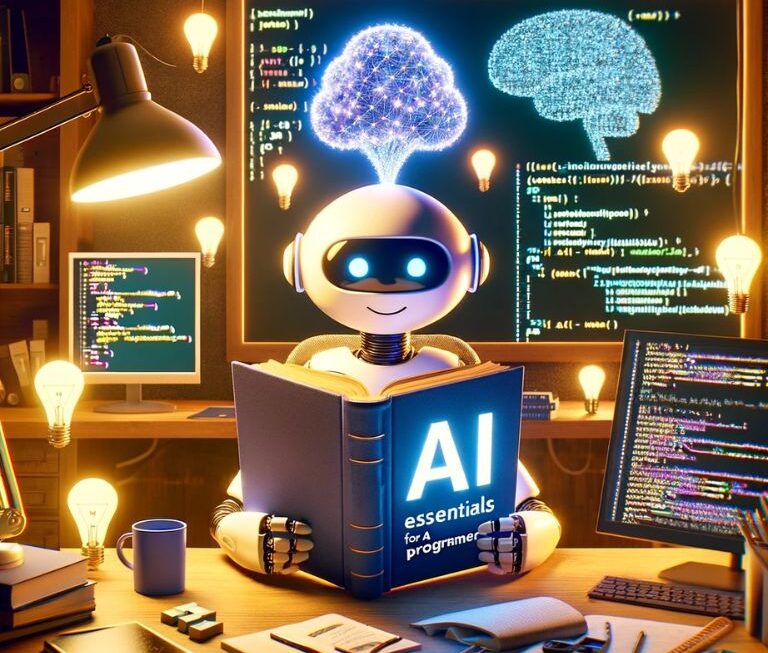GPT-4, the successor to OpenAI’s GPT-3, represents a significant leap in artificial intelligence. With a vastly expanded parameter count and enhanced algorithms, it sets new benchmarks in language comprehension and generation. This advanced model not only excels in processing complex language but also opens up new frontiers in AI applications, promising transformative impacts across various industries.
The Emergence of a New AI Titan
In the rapidly evolving landscape of artificial intelligence, OpenAI’s latest offering, GPT-4, stands as a towering achievement. Building upon the foundations laid by its predecessor, GPT-3, this new iteration is not just an incremental update but a significant leap forward in the capabilities of language models. As we embark on this exploration of GPT-4, it’s essential to understand how it diverges from and improves upon the previous models, setting new benchmarks in the field of AI.
GPT-4 vs GPT-3: A Comparative Glance
- Feature: Model Size
- GPT-3: 175 billion parameters
- GPT-4: Significantly larger
- Feature: Language Abilities
- GPT-3: Advanced, but occasional slips
- GPT-4: More nuanced and context-aware
- Feature: Learning Capacity
- GPT-3: Extensive, with some limits
- GPT-4: Enhanced, with fewer boundaries
- Feature: Application Scope
- GPT-3: Broad
- GPT-4: Even broader, more refined
GPT-4 not only surpasses GPT-3 in terms of raw processing power and model size but also demonstrates a refined ability to understand and generate language. This evolution marks a significant advancement in the model’s capacity to provide contextually relevant and nuanced responses, making it more adept at handling complex language tasks.
Beyond Technicality: A Broader Perspective
While the technical aspects of GPT-4 are undoubtedly impressive, its true significance lies in what it represents for the future of AI. GPT-4 is not just a tool; it’s a harbinger of the enormous potential that AI holds for transforming various aspects of our lives. From enhancing communication and automating mundane tasks to driving innovation in sectors like healthcare, education, and entertainment, GPT-4’s influence is set to be wide-ranging and profound.
Technical Advancements in GPT-4
GPT-4 introduces major technical enhancements over its predecessors, featuring a substantially larger model size and improved processing efficiency. These advancements result in more nuanced language understanding and generation, allowing GPT-4 to provide contextually rich and accurate responses. The model’s increased sophistication not only improves its interaction capabilities but also broadens its applicability, setting a new standard in the field of AI language models.
Pushing the Boundaries of AI’s Capabilities
GPT-4, as the latest frontier in OpenAI’s language models, represents a significant leap in artificial intelligence capabilities. This section delves into the core technical improvements that distinguish GPT-4 from its predecessors, particularly GPT-3, and outlines how these advancements contribute to its superior performance.
Enhanced Model Architecture and Processing Power
At the heart of GPT-4’s advancements is its expanded model size. While the exact number of parameters remains a closely guarded secret by OpenAI, it is widely acknowledged that GPT-4 has significantly more parameters than GPT-3’s 175 billion. This increase in scale translates to a more nuanced understanding of language and context, allowing GPT-4 to generate more accurate and contextually relevant responses.
| Aspect | GPT-3 | GPT-4 |
|---|---|---|
| Parameters | 175 billion | Significantly more than GPT-3 |
| Processing Speed | Fast | Faster, more efficient |
| Contextual Understanding | High | Exceptionally high |
| Response Accuracy | Generally accurate | Highly accurate, even in complexity |
Refined Language Processing Abilities
GPT-4’s enhanced language processing capabilities stem from its refined training algorithms and broader dataset. The model’s ability to understand and generate human-like text has seen substantial improvements, making it more adept at interpreting complex instructions and generating coherent, context-aware content.
| Feature | GPT-3 Capabilities | GPT-4 Improvements |
|---|---|---|
| Contextual Understanding | Advanced | Highly sophisticated |
| Nuance and Subtlety | Moderate | Significantly improved |
| Response Coherence | Good | Excellent, with improved consistency |
Unprecedented Learning and Adaptation
One of the most striking features of GPT-4 is its enhanced learning capacity. Unlike its predecessor, GPT-4 can adapt more dynamically to new information and contexts, showcasing an improved ability to learn from interactions and feedback. This adaptability makes GPT-4 not just a static model but a continually evolving AI tool.
A New Era in AI
The technical advancements in GPT-4 mark a significant milestone in the evolution of AI language models. With its increased model size, enhanced processing power, and improved language capabilities, GPT-4 is poised to revolutionize how we interact with AI, offering unprecedented possibilities in various applications. As we move forward, the impact of these advancements will undoubtedly shape the future trajectory of artificial intelligence.
Enhanced Language Understanding and Generation
GPT-4’s breakthrough lies in its enhanced language understanding and generation, surpassing previous models in depth and accuracy. It exhibits a sophisticated grasp of context, nuance, and idiomatic expressions, enabling more coherent and contextually appropriate responses. This advancement not only refines its conversational abilities but also significantly extends the range and depth of applications in various fields, from creative writing to technical problem-solving.
A New Benchmark in Natural Language Processing

GPT-4 sets a new standard in the realm of natural language processing (NLP). Its enhanced language understanding and generation capabilities represent a significant stride forward, not just for AI models, but for the potential applications of this technology in everyday life. This section explores these improvements and their implications.
Fine-tuned Language Comprehension and Expression
GPT-4’s ability to comprehend and express complex language constructs far exceeds that of its predecessors. This leap is attributed to its advanced algorithms and a more extensive training dataset, enabling a deeper grasp of nuances, idioms, and contextual cues.
Aspect: GPT-3 Performance vs GPT-4 Enhancements
- Understanding Nuance
- GPT-3 Performance: Good
- GPT-4 Enhancements: Exceptional
- Contextual Awareness
- GPT-3 Performance: Advanced
- GPT-4 Enhancements: Highly Advanced
- Expressive Capabilities
- GPT-3 Performance: Solid
- GPT-4 Enhancements: Remarkably Refined
These improvements mean that GPT-4 is not only more adept at understanding the subtleties of language but also at generating responses that are contextually appropriate and nuanced. Whether it’s interpreting complex instructions or engaging in detailed conversations, GPT-4 demonstrates a marked improvement in both comprehension and articulation.
Examples of Nuanced Responses
To illustrate GPT-4’s capabilities, consider these hypothetical examples:
Complex Instruction Interpretation:
- Input: “Can you explain the implications of quantum computing on cybersecurity in layman’s terms?”
- GPT-3 Response: Provides a basic overview.
- GPT-4 Response: Offers a detailed, yet easy-to-understand explanation, highlighting key implications.
Context-Aware Conversation:
- Input: “I’m planning a trip to Japan in April. What should I consider?”
- GPT-3 Response: General travel advice.
- GPT-4 Response: Tailored advice considering April’s specific context in Japan, like cherry blossom season and local festivals.
Implications for User Interactions
The enhanced language capabilities of GPT-4 have profound implications for user interactions. Users can expect more accurate, relevant, and contextually sensitive responses, making GPT-4 an invaluable tool in various applications, from customer service bots to personalized learning assistants.
Revolutionizing Communication
GPT-4’s enhanced language understanding and generation capabilities are not just technical feats; they represent a paradigm shift in how machines understand and interact with human language. As we continue to explore GPT-4’s potential, its role in revolutionizing communication and interaction becomes increasingly apparent.
Applications Across Industries
GPT-4’s advanced capabilities extend its utility across multiple industries, revolutionizing how tasks are approached and solved. In healthcare, it enables more precise diagnostics and personalized care; in education, it offers tailored learning experiences; and in business, it enhances customer engagement and automates complex processes. This versatility underscores GPT-4’s role as a transformative tool, capable of addressing a wide array of sector-specific challenges and opportunities.
GPT-4: Transforming Multiple Sectors
GPT-4, with its advanced language capabilities, is not just a technological marvel; it’s a versatile tool poised to revolutionize numerous industries. This section examines the varied applications of GPT-4, illustrating its impact and potential across different sectors.
Healthcare: Enhancing Patient Care and Research
In healthcare, GPT-4’s ability to process and analyze vast amounts of data can significantly improve patient diagnostics, treatment plans, and medical research. Its capacity to interpret complex medical jargon and patient history can aid in offering more accurate diagnoses and personalized treatment options.
Application and Description
- Patient Diagnostics
- Description: Analyzing symptoms and medical history for accurate diagnosis.
- Treatment Personalization
- Description: Tailoring treatment plans based on individual patient data.
- Medical Research
- Description: Assisting in drug discovery and medical studies.
Education: Personalizing Learning Experiences
GPT-4 can revolutionize the educational sector by providing personalized learning experiences. Its ability to understand and respond to individual student needs can help in crafting custom educational materials, aiding in language learning, and even acting as an interactive tutor.
Application and Description
- Customized Learning Materials
- Description: Creating study content tailored to individual student’s needs.
- Language Learning
- Description: Assisting in learning new languages with conversational practice.
- Interactive Tutoring
- Description: Providing real-time assistance and guidance on various subjects.
Business and Finance: Streamlining Operations
In the business and finance sectors, GPT-4’s applications range from enhancing customer service to automating financial analysis. Its proficiency in processing natural language can lead to more efficient customer interactions and insightful financial forecasting.
Application and Description
- Customer Service Bots
- Description: Delivering efficient and accurate customer support.
- Financial Analysis
- Description: Automating data analysis for market insights.
- Report Generation
- Description: Crafting detailed business reports and summaries.
A Catalyst for Innovation

GPT-4’s applications extend far beyond the boundaries of conventional AI use. Its versatility in adapting to different industry needs underscores its potential as a catalyst for innovation. Whether it’s improving patient care in healthcare, personalizing education, or enhancing efficiency in business, GPT-4 is set to redefine how industries operate.
Ethical Considerations and Challenges
The advent of GPT-4 brings forth complex ethical considerations, primarily focused on data bias, privacy, and the responsible use of AI. Efforts to mitigate biases in training data, safeguard user privacy, and ensure the ethical deployment of GPT-4 are essential. These challenges highlight the need for comprehensive guidelines and standards in AI development, ensuring that GPT-4’s advancements are harnessed ethically and beneficially.
Navigating the Complex Ethical Landscape of Advanced AI
As GPT-4 heralds a new era in artificial intelligence, it brings with it a host of ethical considerations and challenges that must be addressed. This section explores the ethical implications of deploying such an advanced AI model and the challenges that arise in ensuring its responsible use.
Addressing Potential Biases
One of the primary ethical concerns with GPT-4, as with any AI model, is the potential for inherent biases in its responses. These biases can stem from the data used to train the model, which may inadvertently reflect societal prejudices.
Challenge and Mitigation Strategy
- Challenge: Data Bias
- Mitigation Strategy: Implementing diverse and inclusive training datasets.
- Challenge: Unintended Outputs
- Mitigation Strategy: Establishing rigorous testing and feedback mechanisms.
To combat this, continuous efforts are needed to diversify training data and implement checks that can identify and correct biased outputs.
Ensuring Privacy and Data Security
With GPT-4’s ability to process and generate detailed information, concerns around privacy and data security become paramount. Safeguarding user data and ensuring that the model does not inadvertently reveal sensitive information is crucial.
Concern and Solution
- Concern: Data Privacy
- Solution: Implementing robust data encryption and access controls.
- Concern: Information Security
- Solution: Regular audits and updates to security protocols.
Ethical Deployment and Use
The deployment of GPT-4 in various sectors raises ethical questions about its use. For instance, in healthcare or legal settings, the accuracy of GPT-4’s advice and its potential legal implications are critical considerations.
Sector and Ethical Concern
- Sector: Healthcare
- Ethical Concern: Accuracy of medical advice and diagnostics.
- Sector: Legal
- Ethical Concern: Reliability in legal advice and documentation.
Developing Ethical Guidelines and Standards
To navigate these ethical challenges, the development of comprehensive guidelines and standards for the use of GPT-4 is essential. This involves collaboration between AI developers, ethicists, industry experts, and regulatory bodies to ensure that GPT-4 is used responsibly and ethically.
A Responsible Approach to AI Innovation
The ethical considerations and challenges surrounding GPT-4 underscore the need for a responsible and informed approach to AI development and deployment. By addressing these issues proactively, we can harness the benefits of GPT-4 while mitigating its risks, ensuring that this groundbreaking technology serves the greater good.
Future Potential and Upcoming Developments
GPT-4’s ongoing evolution hints at exciting future enhancements, including more sophisticated language understanding, adaptive learning algorithms, and multimodal capabilities. These anticipated developments promise to further integrate AI into various sectors, enhancing personalization and efficiency. The continued advancement of GPT-4 and its successors will not only refine AI technology but also redefine its role in shaping our future.
Envisioning the Future with GPT-4
GPT-4 is not just a milestone in the present landscape of artificial intelligence; it’s a beacon for future possibilities. This section delves into the potential future trajectory of GPT-4 and its successors, discussing anticipated features, capabilities, and the impact they may have.
Predicting Enhancements in GPT-4 and Beyond
The ongoing development of GPT-4 and its successors is expected to bring numerous enhancements. These could include further improvements in language comprehension, greater adaptability to different contexts, and more sophisticated interaction capabilities.
Future Enhancement and Anticipated Impact
- Future Enhancement: Advanced Contextual Understanding
- Anticipated Impact: More nuanced interactions and accurate responses.
- Future Enhancement: Adaptive Learning Algorithms
- Anticipated Impact: Continuous improvement from user feedback.
- Future Enhancement: Enhanced User Interaction
- Anticipated Impact: More human-like and engaging conversational abilities.
Speculating on New Features
As GPT-4 continues to evolve, we can speculate about new features that might be introduced. These could range from more advanced emotional intelligence in responses to the integration of multimodal inputs, allowing GPT-4 to process and respond to a combination of text, voice, and even visual cues.
Potential Feature and Description
- Potential Feature: Emotional Intelligence
- Description: Responding to user emotions in a more nuanced way.
- Potential Feature: Multimodal Capabilities
- Description: Processing and integrating multiple forms of input.
The Impact on Various Industries
The advancements in GPT-4 are expected to have a profound impact on various industries. In fields like healthcare, education, and customer service, the enhanced capabilities of GPT-4 could lead to more personalized and effective solutions.
Industry and Potential Impact
- Industry: Healthcare
- Potential Impact: Improved diagnostics and personalized treatments.
- Industry: Education
- Potential Impact: More tailored and interactive learning experiences.
- Industry: Customer Service
- Potential Impact: More efficient and empathetic customer interactions.
Shaping the Future of AI and Technology
The future potential of GPT-4 and its successors is boundless. With each advancement, we move closer to a world where AI is not just a tool, but a partner in various aspects of life and work. The upcoming developments in GPT-4 promise to further this partnership, shaping the future of AI and technology in ways we are only beginning to imagine.
The Impact of GPT-4 on Society and Technology
GPT-4 represents a significant milestone in the AI landscape, redefining the boundaries of machine intelligence. Its advanced language processing capabilities and broad applicability have profound implications for numerous sectors, from healthcare and education to business and creative arts. The model’s ability to understand context, generate coherent responses, and learn from interactions makes it an invaluable asset, driving innovation and efficiency across industries.
However, GPT-4’s emergence also brings to light important ethical and societal challenges, including concerns about data privacy, potential biases, and equitable access to technology. Addressing these challenges is crucial for harnessing the full potential of GPT-4 in a responsible manner. As we embrace this new era of AI, it’s imperative to balance the technological advancements with mindful consideration of their impact, ensuring that GPT-4 benefits society as a whole.




